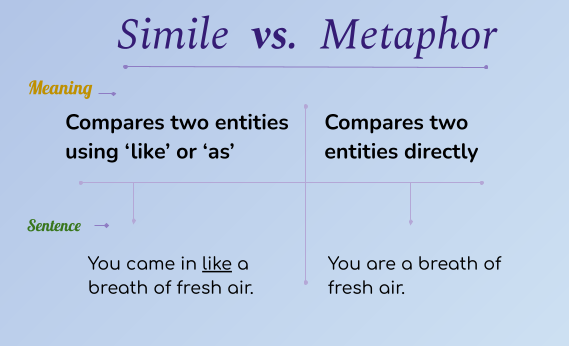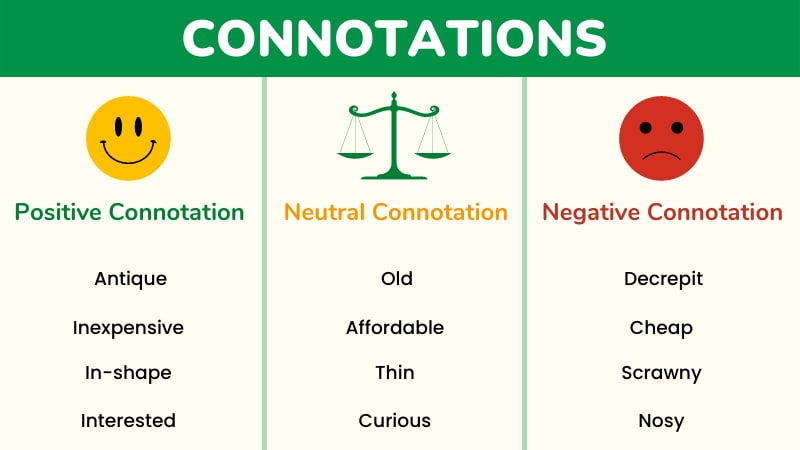Simile vs. Metaphor - Know the Difference

Simile and metaphor are both distinct figures of speech that are often used in literature for ornamental purposes. Writers choose to use these figurative devices to amplify the effect on language by creating imagery in the mind of the readers.
Simile
This rhetorical device is used to draw a comparison between two far-fetched entities by using the words ‘like’ or ‘as’ in the statement. Similes are used in everyday language as well as literature. Some examples of simile are given below -
- You shine bright like the stars above.
- I want teeth as white as pearls.
- She roared like a lioness.
- I wish I could swim like a fish.
Metaphor
Metaphors compare two things directly without the use of any connecting or helping words. Metaphors are often difficult to fathom for their sudden usage in literary language but authors and poets have used them with utmost expertise throughout history. Check out a few examples of metaphors -
- She is my moon on the darkest of nights.
- Flynn has a heart of ice.
- I’m always buried under a sea of paperwork.
- Time is money.
The Difference: Simile vs. Metaphor
In terms of the cause of use, simile and metaphor barely have any difference since they are used for the very same effect in language and literature. The sole difference comes in their usage and the assisting words used alongside.
- You came in like a breath of fresh air. (Simile)
The use of the word “like” makes “breath of fresh air” a simile and not a metaphor.
- You are a breath of fresh air. (Metaphor)
The lack of assisting words (like or as) used in the sentence to compare “You” and “breath of fresh air” and makes it a metaphor.
Essentially, the usage of ‘like’ or ‘as’ makes all the difference when it comes to detecting the comparison done is with the help of a simile or metaphor.
Compassion Table
The comparison table below would come in handy for clearing out any confusion left by putting them side by side. Let’s have a look at what are the similarities and dissimilarities between similes and metaphors.
|
Factors |
Simile |
Metaphore |
|
Cause |
Far-fetched comparison |
Far-fetched comparison |
|
Used in |
Everyday language and literature |
Majorly in literature |
|
Assisting word |
“Like” or “As” |
N/A |
|
Interpretation |
Less room for varied interpretation |
Open to readers’ interpretation |
Simile or Metaphor?
It is a huge decision to make when choosing between similes and metaphors. A writer has to choose between the two when there is a scope for comparison in their work. It always comes down to the kind of impact they want to have on their readers.
Metaphors often have deeper meanings and give power to the readers since they can be interpreted in various ways and so, have a grander impact on the readers’ minds. Writers, on the other hand, need to be very careful as to what suits the mood of the piece. In the case of bigger literary pieces, writers can work their magic and strike a good balance of similes and metaphors so that readers can enjoy the magical experience without being put off by their forced overuse.
Grammar
Read More
- How to Use "Therefore" in Sentences Avoiding Common Mistakes
- How to Use "Whereas" with Examples and Avoid Common Mistakes
- When and How to Use "Thus" Correctly Without Common Mistakes
- How to Use "On the Contrary" Properly with Meaning and Examples
- When and How to Use "Either/Or" with Examples and Common Mistakes to Avoid
- How to Use "On the Other Hand" Effectively without Mistakes
- How to Use "Respectively" with Example and Common Errors to Avoid
- How and When to Use "Moreover" Without Mistakes
- How to Use "Likewise" in Sentences Based on Context & When not to Use
- When & How to Use "Although" in Sentences to Avoid Mistake

